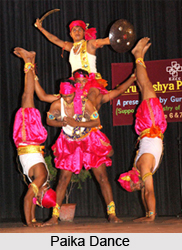 Paika dance is a famous dance form of Odisha which is practiced by the paikas of Oriya army. The main target of this dance is to enhance the physical excitement and to develop the inner courage. The tradition of this dance is carried throughout the huge area of tribal belt of Mayurbhanj district.
Paika dance is a famous dance form of Odisha which is practiced by the paikas of Oriya army. The main target of this dance is to enhance the physical excitement and to develop the inner courage. The tradition of this dance is carried throughout the huge area of tribal belt of Mayurbhanj district.
Etymology of Paika dance
The term Paika is derived from Sanskrit word `Padatika` meaning the infantry. The Paika dance of Odisha has a martial art character and is performed with shields and swords. This dance displays the skills and the ability of the dancers to handle these weapons. Hence, the name of the dance is Paika (battle) dance.
Performance of Paika Dance
The dance is performed in a group. Men as warriors appear for the performance, in their colourful turbans and tight dhotis and stand in two rows. Holding the wooden swords and shields in their hands, warriors engage in a fierce mock-combat. They come forward slowly towards each other, but the tempo of the performance increases suddenly. This indicates the beginning of the battle and with it they whirl their swords and attack each other. The dance reaches its climax with the fast beats produced by `Mandal`. For all such special occasions, grounds are purposely prepared with soft earth sprinkled with oil and water.
In olden days, the powerful Ganga and Gajapati rulers of Odisha extended their territory borders from the Ganga River in the north to Godavari in the south with the help of a vast army of valiant Paikas, for which, these received huge land grants from the kings. They formed the rank of a peasant-military; agriculture was their main earning source, but they often keep themselves ready with regular practice and training of the war techniques. Most of the Paika villages of state have maintained the older tradition of Paika Akhada. Paika Akhada is the village gymnasium where young people assemble in the evening after completing their work. Along with performing the traditional physical exercises at Paika Akhada, they also dance with sword and shield with the accompaniment of the country-drums.
During the festival of Dussehra, all the Akhadas celebrate their annual festivals and display traditional gymnastics, acrobatics during the various village-groups competitive performances. Each group participates with great enthusiasm in such occasions.
Musical Instruments of Paika Dance
This dance is accompanied by the music of Narsingha, shehnai, Bheir and the Dhak and Nagara drums.
Paika dance is also practiced in the Jharkhand state of India. This form is done only by the male members of the society. In Jharkhand while doing this dance men risk their lives to perform it.



















